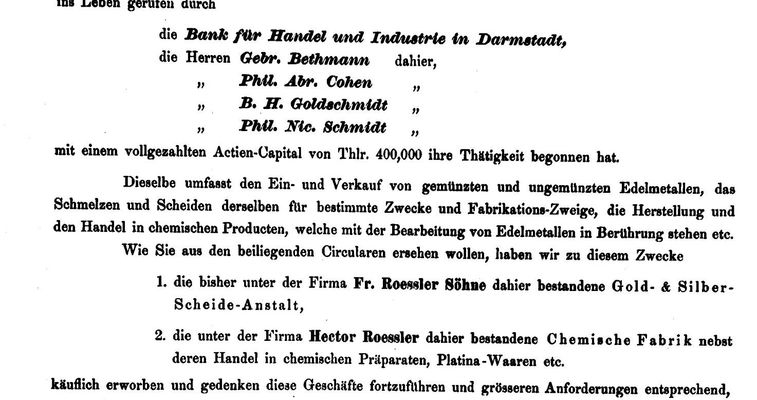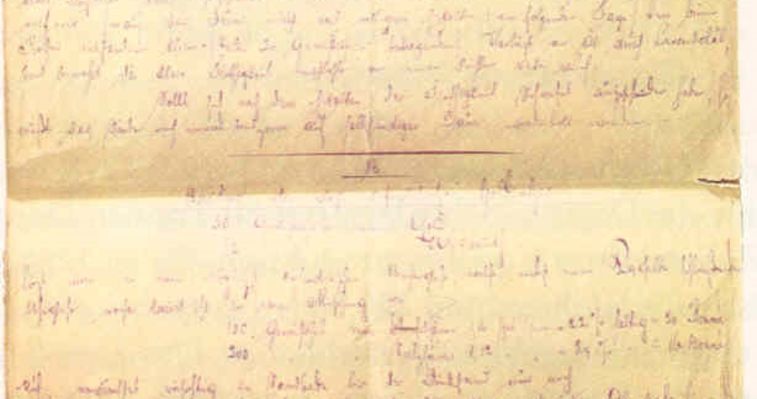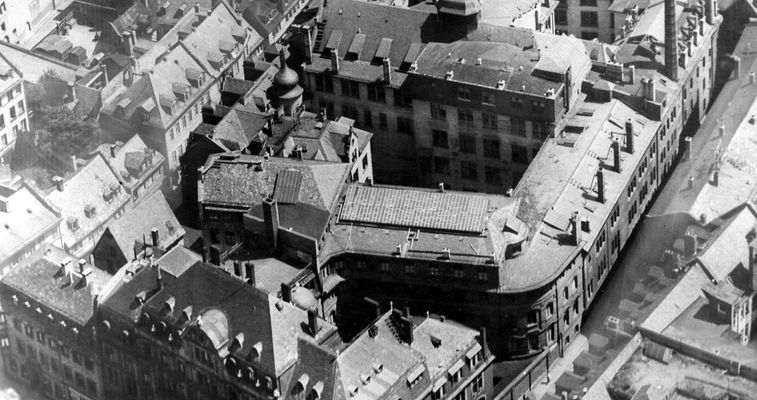History of the former Degussa AG
Degussa AG (Deutsche Gold- und Silber-Scheideanstalt vormals Roessler) [German Gold and Silver Refinery formerly Roessler] prior to 2007
Beginnings as a gold and silver separation factory
The history of former Degussa began in the half of the 19 century, when the head of the Frankfurt Mint, Friedrich Ernst Roessler, established a gold and silver separation factory at the city’s request in 1843. Furthermore, Roessler initiated the construction of a chemical-technical laboratory close to the Mint, on the premises of today’s Evonik site. This laboratory processed the byproducts of sulfuric acid separation, namely silver nitrate and cyanide salts. When Frankfurt lost its political independence in 1866 as a consequence of the Prussian-Austrian War, Friedrich Ernst Roessler became a Prussian civil servant and withdrew from the separation business. His eldest sons, Hector and Heinrich, both chemists, took over operations. They transferred the separation factory to the chemical-technical laboratory and continued both activities as the company Friedrich Roessler Söhne.
Establishment of Deutsche Gold- und Silber-Scheideanstalt

Document of foundation of Deutsche Gold- und Silber-Scheideanstalt, 1873
When the German Empire was formally established in 1871, a standard currency was introduced: mark and pfennig. They replaced all other currencies used in the former German states. Because of the large volume of coins that then had to be refined, the government demanded security guarantees from the Roessler brothers, which could be met only by incorporating the precious metal refinery.
Thus, several banks established Deutsche Gold- und Silber-Scheideanstalt vormals Roessler (German Gold and Silver Refinery formerly Roessler), in January 1873. Hector and Heinrich Roessler were appointed to the posts of directors. Because of the long and unwieldy company name, it was commonly referred to as the “Scheideanstalt” for decades. The name “Degussa” became more popular in the 1930s on the basis of the company’s telegram abbreviation. It took until 1980 to enter Degussa formally into the Commercial Register as a new company name.
First new products and expansions

Receipt for gold foil
Once the large volume of invalidated coins had been processed, Deutsche Gold- und Silber-Scheideanstalt developed its own process for making bright gold in 1879, a fireproof material for decorating porcelain and glass. The global success of this invention established the foundations for the Ceramic Paints Business Unit, which Degussa would spin off as Cerdec AG in 1993. The company became part of the newly founded dmc on January 1, 2000, together with the Precious Metals and Exhaust Catalysts Business Units. This company was divested in August 2001 and is now owned by the Belgian Umicore Group, while the U.S.-based Ferro Inc. purchased the ceramic paints business.

Price list for ceramic colours, before 1900
Working with an English partner, Deutsche Gold- und Silber-Scheideanstalt founded the Electro-Chemische Fabrik Natrium GmbH in 1898, with a production site in Rheinfelden at the upper Rhine. This facility produced the sodium Degussa needed for its cyanide salt manufacture. In 1999, this plant was united with the adjacent Rheinfelden plant of the former Hüls AG as part of the merger.
Expansion into new business sectors
When the political situation during and immediately after the World War made an internationally aligned business policy impossible, Deutsche Gold- und Silber-Scheideanstalt focused its efforts on partnerships in and acquisition of domestic production facilities. The company had held shares in Chemische Fabrik Wesseling AG since 1905. This plant produced mainly potassium ferro-cyanide and forms the basis of today’s Wesseling site of Evonik Industries.
The partnership in the platinum smelter G. Siebert in Hanau in 1906 allowed Deutsche Gold- und Silber-Scheideanstalt to become active in semifinished precious metal production. In 1919, the precious metal processing company Dr. Richter & Co. of Pforzheim was added to the portfolio. This would later develop into the main production site of the Dental Business Unit. In 1995, all dental activities were concentrated at the Wolfgang site near Hanau. They were divested jointly in July 2000 as Degussa Dental GmbH & Co. KG as part of Degussa’s effort to focus on specialty chemicals. The U.S.-based company Dentsply International Inc. of York, PA, acquired the business in October 2001.
Promising new business sectors

Degussa in Frankfurt am Main, around 1930
Deutsche Gold- und Silber-Scheideanstalt gained access to an important new business sector, organic chemicals, in 1930/31 when it purchased two major wood carbonization companies, namely Holzverkohlungsindustrie AG (HIAG) of Konstanz and Verein für Chemische Industrie of Mainz. These acquisitions added a large number of organic chemicals to the product portfolio of Degussa. These included methanol and acrolein, which would achieve a breakthrough after the Second World War in methionine synthesis, and—jointly with BASF AG—the synthetic material polyoxymethylene. A new process to produce waterless alcohol, which was sold as a fuel additive, proved highly successful.
In 1932, Degussa acquired a small lampblack factory in Kalscheuren near Cologne, laying the foundations for its important future business with industrial carbon blacks. A new process invented in 1934 resulted in the production of the active gas black CK3, which quickly gained importance in the expanding tire industry and became a strong competitor for the predominant American carbon black producers.
The carbon black business and the Kalscheuren site were sold on August 1, 2011.
The Nazi era
During the Nazi era, Deutsche Gold- und Silber-Scheideanstalt expanded its precious metal and chemicals business in line with the regime’s autarkical program. As a result, carbon black developments were advanced significantly with government subsidies. The company also developed new production processes on the basis of domestic raw materials and acquired further companies through the “Aryanization” campaign.
The history of Deutsche Gold- und Silber-Scheideanstalt during the Nazi era and immediately after the Second World War has been investigated in two scientific studies. The renowned U.S. historian Prof. Peter Hayes (Northwestern University) published the book From Cooperation to Complicity: Degussa in the Third Reich in September 2004. The German edition was published by C.H. Beck Verlag, Munich, while the English version is available through Cambridge University Press, New York.
The economic historian assistant professor Dr. Ralf Banken (Goethe University of Frankfurt on the Main) has studied the use of foreign currencies during the Third Reich. Gold was among the most important foreign currency sources of the Nazis and was used to purchase goods for the war effort in other countries. Degussa’s precious metal refineries served to refine stolen gold on behalf of the Nazi regime. Once refined, the gold was returned to the treasury, with the exception of a portion designated for industrial use, which Degussa was entitled to distribute. Dr. Banken’s study was published in 2009 (only available in German). For further information on this research study, please refer to the section "Degussa in the national socialist era."
Economic recovery and fresh start
Toward the end of WWII in May 1945, the production of nearly all plants came to a temporary halt. At some sites, up to 75 percent of buildings and facilities had been destroyed. The company lost its international holdings and subsidiaries and facilities located in Eastern Germany were seized. The plants in Western Germany came under trustee management and were partly dismantled.
During the reconstruction, the broad portfolio of Deutsche Gold- und Silber-Scheideanstalt offered many opportunities for economic recovery. The currency reform of June 1948 created excellent conditions for a fresh economic start. During the same year, Deutsche Gold- und Silber-Scheideanstalt began the reconstruction of its Frankfurt-based administrative building on the old foundations with a new design.
Internationalization of Degussa
In 1953, Deutsche Gold- und Silber-Scheideanstalt founded Bragussa s.a. as the foreign production facility established after the Second World War. As part of this effort, the company built a plant for the manufacture of colorants and auxiliary materials for the ceramics industry, along with galvanic precious-metal dips and surface treatment salts in a location close to Sao Paulo, Brazil. The production at the Mauá plant began in 1955. In 1979, this company would merge with other Brazilian subsidiaries to become Brazilian Degussa s.a.
To satisfy foreign demand, Degussa set up sales organizations all over the world in the 1950s, including in France, Great Britain, the U.S., Mexico, Argentina, and South Africa.
Since production capacities for sodium perborate, AEROSIL, cyanuric acid, and cyanuric chloride were no longer sufficient in Germany in the late 1960s, Deutsche Gold- und Silber-Scheideanstalt set up a major chemical plant in the Belgian city of Antwerp. The production facilities became operational in 1970.
The construction of the company’s major chemical plant in the USA began a few years later in Mobile, Alabama. Degussa Corporation, established in 1977 in the USA, became the largest foreign investment focus of the Group.
The introduction of strict exhaust regulations in the USA and Japan led to the stepped-up production of automotive emission control catalysts at Rheinfelden. Thanks to its global production network, the former Degussa was among the most important manufacturers of these catalysts. These activities were spun off to dmc2 AG in 2000 and divested shortly afterwards.
Degussa became active in carbon blacks in United States during the 1980s, where it acquired Ashland Oil Inc.’s carbon black production and formed its own Degussa Carbon Black Corporation. At the same time, it also bought the European carbon black plant of the Bartlesville, Oklahoma-based Phillips Petroleum Company. These acquisitions also drew carbon black plants in France, the Netherlands, Sweden, and Italy into the company’s orbit.
Realignment in Asia
The growing influence of Japan and the growth of Southeast Asian economies prompted Degussa to set up production sites and technical service centers in addition to sales companies in this region. Thus Degussa, in a partnership with Mitsubishi Metal Mining Co. Ltd., formed Nippon Aerosil Co. Ltd., Tokyo, for the production and distribution of AEROSIL in 1966. This was followed by the establishment of the distribution company Japan Co. Ltd. in Tokyo in 1969. Five years later, Degussa China Ltd. was formed in Hong Kong as a distribution company for the Far East, followed by the establishment of Degussa Pacific Ltd. in Hong Kong in 1984. Branch offices were opened in Seoul, Taipei, as well as in the Chinese cities of Shanghai, Beijing, and Shenzhen. The establishment of Quingdao Degussa Chemical Company Ltd. in 1994 represented the German-Chinese joint venture in carbon blacks for rubber and tires.
In February 1999, Degussa AG merged with the VEBA subsidiary Hüls AG of Marl to become the new Degussa-Hüls AG with headquarters in Frankfurt/Main. As part of the merger of VEBA and VIAG to form EON AG, Degussa-Hüls and the VIAG subsidiary SKW Trostberg AG were combined in 2001 to form Degussa AG of Düsseldorf.
In several stages ending in 2006, Essen-based RAG Beteiligungs AG acquired all shares of Degussa AG, which subsequently was converted to a GmbH (limited liability company under German law). After RAG Beteiligungs AG was converted to Evonik Industries AG on September 12, 2007 the businesses of the former Degussa GmbH were transferred to the new company.
